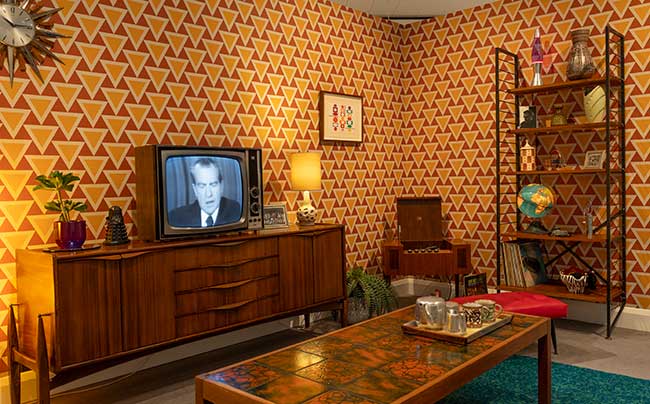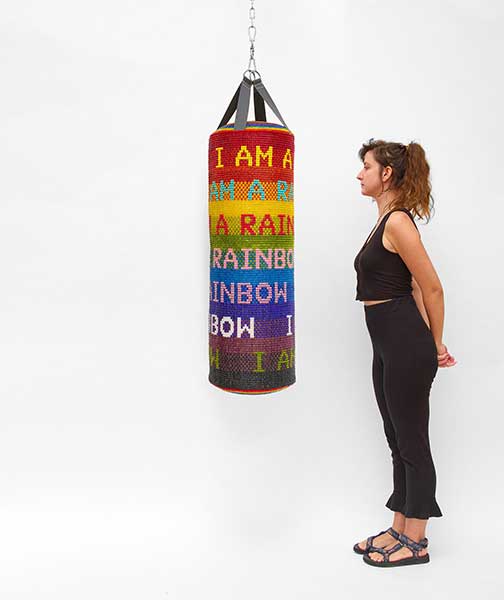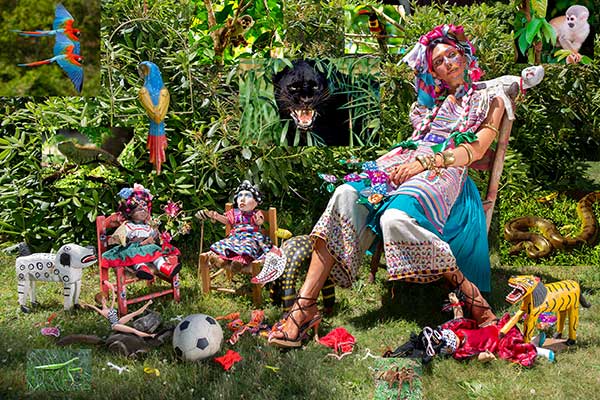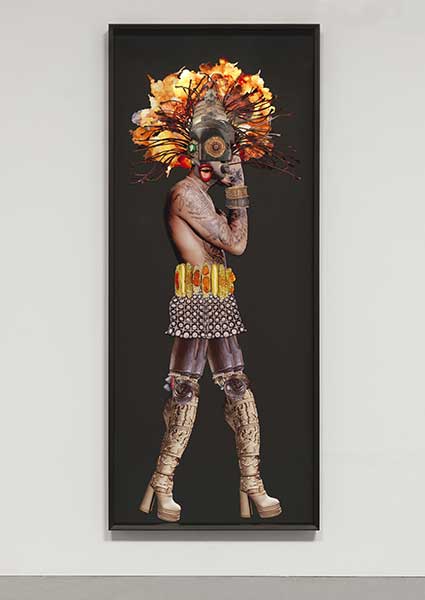Living art and urgent questions

Since its opening in 1978 the Sainsbury Centre for Visual Arts has been a genre-defying art museum with world-class collections and a unique perspective on how art can foster cultural dialogue and exchange. Sir Robert and Lady Sainsbury donated their extraordinary art collection, which includes works dating from prehistory to the late 20th century from across the globe, to the University of East Anglia (UEA) and asked a young Norman Foster to create a radical alternative to the traditional art museum. As his first public work, Foster designed a radical new building to house the collection.
Building on these radical foundations, Dr Jago Cooper, as Director of the Sainsbury Centre, and his team have been helping people find new ways to move, feel, think, and activate themselves within the museum and build new relationships with living work of arts in their own way. These approaches include: a pay what you can afford entry scheme; curated journeys through the collection; a Handbook for Meeting Living Art which suggests practical steps and techniques; and a new Living Art exhibition that allows visitors, who don’t want digital or text-based approaches, to feel what is meant when thinking about living art.

The Sainsbury Centre has also embarked on a new approach to exhibition programming, empowering art to address fundamental societal challenges. Artworks from all over the world are travelling to the Sainsbury Centre to pose urgent, global questions to visitors and to help them to find the answers. This is a new aspect to their radically new approach that understands art as alive and capable of engaging people with the fundamental questions of life.
The first of their new seasons was Planet for our Future which explored how we adapt to a transforming world, The current season is investigating how we can know what is true in the world around us through a series of fascinating, interlinked exhibitions.

For more than twenty years Cooper has worked for and with museums, universities, cultural ministries and heritage organisations around the world to explore and communicate aspects of the great human story. His research has ranged broadly across universal questions facing global society including climate change, colonial encounter, technological revolution, and social innovation. His books and publications provide innovative perspectives on cultural experience and interpretation of material expression. He has also written and presented programmes for BBC Four, primarily on the ancient histories of the Americas.

I asked him about the relaunch of the Sainsbury Centre and his hopes for its wider impact.
JE: 2023 marked 50 years since Sir Robert and Lady Sainsbury donated their art collection to the University of East Anglia and asked a young Norman Foster to create a radical alternative to the traditional art museum. To mark this anniversary the Sainsbury Centre was relaunched in ways that sought to build on its origins in order to then present an alternative model of what a museum is and how visitors can meet art in the 21st-century. What were the key elements of that relaunch and why were they chosen?
JC: The key aim of the relaunch was to reframe the role of the museum in the 21st century. Because of the radical foundations of the Sainsbury Centre in the 1970s we have a unique mandate here to able to reinvent both who and how art is experienced within our beautiful galleries. We did this by creating quite a radical framework in which we understand our collection as being alive, that great artists have an ability to channel that unique essence of human lifeforce and materialise it, building on this concept we have created a series of ways for visitors to more actively and emotionally engage with our collection.
JE: The relaunch provided an environment and experiences that then enabled the introduction of a radically different exhibition programme with a series of six-month seasons centred on fundamental societal challenges explored by living art. We’re now in the second season (What is Truth?) of this programme. What has particularly excited you about the programme to date and what did you learn from the first six-month season (Planet for our Future: How do we adapt to a Transforming World?)?
JC: What I have loved most of all about this season is how it is attracting a new audience to our museum. People that are fascinated by the question and our approach rather than just being traditional museum goers who always enjoy seeing incredible art. Because this exhibition delves into Artificial Intelligence, fake news and fundamental questions about our self-identity, you can see the people in the galleries really thinking about these big questions as they go round, inspired by the incredibly creative ways the artists we have collaborated with have chosen to take our visitors on a journey. What we have learnt is that despite the enormity of these questions around climate change and truth, people really enjoy having a museum that lets them explore these challenging topics with inspiration, hope and information provided by the artists and exhibitions we have created.
JE: You’ve said that the original ambition of the Sainsbury Centre founders means it is one of the few museums in the country where there is a chance to pull off some tangible and radical institutional change. What aspects of those original ambitions have you engaged with in the relaunch and how have you done so?
JC: The founders of the Sainsbury Centre explicitly set out to break the traditional rules of the art museum. They created an equal platform for all forms of art no matter where and when it was made in the world. They took art off the walls and created a three dimensional Living Area of cultural dialogue across the stunning architectural landscape designed by Sir Norman Foster. They invited each visitor to take ownership of their own journey through the gallery, explaining that there was no right or wrong way to meet and engage with art. We have taken these concepts and reinvigorated them within the revolutionised societal context of today, introducing image recognition apps on your smartphone to find out the life story of each work on display, bringing in experts, artists and those with lived experience from all around the world to share their story telling through the artworks in our living area.
JE: The Living Area of the Sainsbury Centre currently has some wonderful curation, such as the Paul Cocksedge installation that is directly above a Giacometti figure and the Francis Bacon paintings that are in dialogue one with the other. To what extent is relationality informing what you do and are at the Centre?
JC: One of the primary functions of a museum is to create fascinating cultural dialogues through time and space. The diverse curatorial team here take a lot of time to consider and build these relationships in the gallery and allow our visitors to participate in the fascinating conversations that ensue.
JE: What has been most encouraging about responses to the relaunch to date?
JC: The most encouraging response has been the hugely supportive way our friends and colleagues in other museums across the world have helped us develop the ideas and experiences within the galleries. It feels very much like this has been a collaboration and I hope people have enjoyed the conversations as much as we have enjoyed delivering on them.
JE: You’ve achieved a lot very quickly. What are your next steps and how will you consolidate the change that has already been achieved?
JC: The next steps for building the ‘updated museum’ will be the development of a creative agency, media company and multi sensorial visitor attraction, which aims to activate art to engage people with the biggest questions people have in their life as part of our future programme. The media company will aim to capitalise on contemporary broadcast media to modernise the way we share the stories from the creative agency out into the world, and the enhanced visitor experience is to provide a more interactive and dynamic experience across our whole museum landscape.
JE: How will you know you are achieving your goals? What are some of the key markers and indicators going forward?
JC: The key goals are both qualitative and quantitative, we would like to attract more visitors to experience what we have created and for them to have a richer and more engaged experience when they are here.
JE: Why do you think an alternative model of what a museum is and how visitors can meet art is needed in the 21st century?
JC: Because society is continually changing and the main questions that people want answered now are different to the questions of the 18th, 19th and 20th centuries, when most museums were created.
JE: What do you hope the wider ramifications of the alternative model you are developing might be in the longer term?
JC: I hope that we will attract and build a wider community of people who love the Sainsbury Centre and want to collaborate and support us. That is what we all live and work so hard for at the Sainsbury centre.
What is Truth?, The Sainsbury Centre for Visual Arts: In Event of Moon Disaster, 17 February – 4 August 2024; Liquid Gender, 17 February – 4 August 2024; Jeffrey Gibson: no simple word for time, 24 February – 4 August 2024; The Camera Never Lies: Challenging images through The Incite Project, 18 May – 20 October 2024
Jago Cooper
The images are:
In Event Of Moon Disaster at the Sainsbury Centre. Photo: Kate Wolstenholme © MIT and Halsey Burgund
Martine Gutierrez, Queer Rage, Imagine Life-Size, and I’m Tyra, p66-67 from Indigenous Woman, 2018. © Martine Gutierrez; Courtesy of the artist and RYAN LEE Gallery, New York
Rashaad Newsome, Afro-fabulations 9, 2023 © Rashaad Newsome
Jeffrey Gibson, I am a Rainbow, beaded punching bag © Jeffrey Gibson. Courtesy the artist, Stephen Friedman Gallery, Sikkema Jenkins and Co. and Roberts Projects. Photo: Max Yawney
